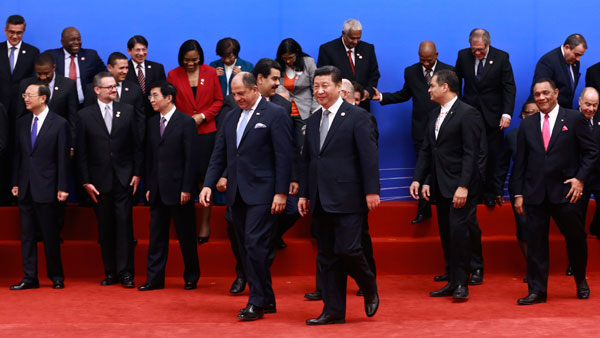A South-South cooperation framework
Updated: 2015-01-09 09:59
By Gina Caballero(China Daily)
|
||||||||
 |
|
President Xi Jinping and guests attend a photo session during the opening ceremony of the first Ministerial Meeting between China and the Community of Latin American and Caribbean States. FENG YONGBIN / CHINA DAILY |
The opening of the China-CELAC Forum (CELAC is the abbreviation of Community of Latin America and Caribbean States) in Beijing follows the intense activity the two sides have had over the past years.
President Xi Jinping has visited the region twice in two years. During his last visit in July 2014, he attended the China-Latin America and the Caribbean Leaders Summit in Brasilia, Brazil, where the establishment of the forum was announced. More than 11 heads of state of Latin American countries have visited China during the same period. And high-ranking officials and scholars from different institutions in China and CELAC have exchanged visits to promote and smoothen dialogue.
The forum in Beijing this week, which will bring together the presidents of Cuba, Ecuador, Costa Rica and Bahamas, and foreign ministers and other high-level officials from China and CELAC countries, will undoubtedly be a milestone in China-CELAC relations. It comes after a dynamic decade of trade and economic relations; two-way trade jumped from $12 billion in 2000 to $261.75 billion in 2013.
Also, according to estimates by the UN Economic Commission for Latin America and the Caribbean, China with its share of the region's exports at 10 percent and imports at 16 percent was set to replace the European Union as the second-largest trading partner of Latin America in 2014. Thanks to this market drive, China and the region have bridged the enormous knowledge gap they had since they started interacting in earnest in 2000.
But despite that, China and Latin America and the Caribbean still face serious limitations in mutual understanding, which could thwart their efforts to address the structural challenges their economic interactions have been encountering - such as the over-concentration of the region's exports on a small number of commodities. According to United Nations COMTRADE, 73 percent of the region's exports to China in 2013 were made up of commodities, while for the world they added up to 41 percent. And although Chinese foreign direct investment in CELAC has been growing significantly since 2010, at roughly $9-10 billion a year, it is still in its initial stages and concentrated again on natural resources.
- Inspection teams to cover all of military in anti-corruption drive
- Tornado, heavy rain batters Central China's Hunan
- Beijing's five-year plan: Cut population, boost infrastructure
- Palace Museum discovers relics buried for over 600 years
- Disney promises ‘safe, pleasing service of high quality’
- Couple detained for selling their two sons
- Rousseff: Accusations against her 'untruthful'
- Almost one-sixth of Brazil's confirmed microcephaly cases linked to Zika
- Impeachment trial against Rousseff recommended to senate
- With nomination secured, Trump to aim all guns at Hillary Clinton
- Obama sips Flint water, urges children be tested for lead
- Massive protests against Abe mark Japan's Constitution Memorial Day

 Raging wildfire spreads to more areas in west Canada
Raging wildfire spreads to more areas in west Canada
 World's first rose museum to open in Beijing
World's first rose museum to open in Beijing
 Teapot craftsman makes innovation, passes down techniques
Teapot craftsman makes innovation, passes down techniques
 Top 8 iOS apps recommend for mothers
Top 8 iOS apps recommend for mothers
 Five things you may not know about the Start of Summer
Five things you may not know about the Start of Summer
 Art imagines celebrities as seniors
Art imagines celebrities as seniors
 Japanese animator Miyazaki's shop a big hit in Shanghai
Japanese animator Miyazaki's shop a big hit in Shanghai
 Star Wars Day celebrated around world
Star Wars Day celebrated around world
Most Viewed
Editor's Picks

|

|

|

|

|

|
Today's Top News
Liang avoids jail in shooting death
China's finance minister addresses ratings downgrade
Duke alumni visit Chinese Embassy
Marriott unlikely to top Anbang offer for Starwood: Observers
Chinese biopharma debuts on Nasdaq
What ends Jeb Bush's White House hopes
Investigation for Nicolas's campaign
Will US-ASEAN meeting be good for region?
US Weekly

|

|







